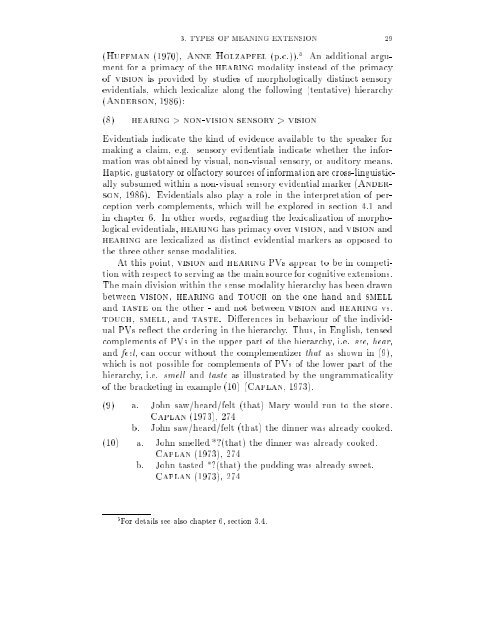Perception verb complements in Akatek, a Mayan language
Perception verb complements in Akatek, a Mayan language
Perception verb complements in Akatek, a Mayan language
You also want an ePaper? Increase the reach of your titles
YUMPU automatically turns print PDFs into web optimized ePapers that Google loves.
3. TYPES OF MEANING EXTENSION 29<br />
(Huffman (1970), Anne Holzapfel (p.c.)). 5 An additional argument<br />
for a primacy of the hear<strong>in</strong>g modality <strong>in</strong>stead of the primacy<br />
of vision is provided by studies of morphologically dist<strong>in</strong>ct sensory<br />
evidentials, which lexicalize along the follow<strong>in</strong>g (tentative) hierarchy<br />
(Anderson, 1986):<br />
(8) hear<strong>in</strong>g > non-vision sensory > vision<br />
Evidentials <strong>in</strong>dicate the k<strong>in</strong>d of evidence available to the speaker for<br />
mak<strong>in</strong>g a claim, e.g. sensory evidentials <strong>in</strong>dicate whether the <strong>in</strong>formation<br />
was obta<strong>in</strong>ed by visual, non-visual sensory, or auditory means.<br />
Haptic, gustatory or olfactory sources of <strong>in</strong>formation are cross-l<strong>in</strong>guistically<br />
subsumed with<strong>in</strong> a non-visual sensory evidential marker (Anderson,<br />
1986). Evidentials also play a role <strong>in</strong> the <strong>in</strong>terpretation of perception<br />
<strong>verb</strong> <strong>complements</strong>, which will be explored <strong>in</strong> section 4.1 and<br />
<strong>in</strong> chapter 6. In other words, regard<strong>in</strong>g the lexicalization of morphological<br />
evidentials, hear<strong>in</strong>g has primacy over vision, and vision and<br />
hear<strong>in</strong>g are lexicalized as dist<strong>in</strong>ct evidential markers as opposed to<br />
the three other sense modalities.<br />
At this po<strong>in</strong>t, vision and hear<strong>in</strong>g PVs appear to be <strong>in</strong> competition<br />
with respect to serv<strong>in</strong>g as the ma<strong>in</strong> source for cognitive extensions.<br />
The ma<strong>in</strong> division with<strong>in</strong> the sense modality hierarchy has been drawn<br />
between vision, hear<strong>in</strong>g and touch on the one hand and smell<br />
and taste on the other - and not between vision and hear<strong>in</strong>g vs.<br />
touch, smell, and taste. Di erences <strong>in</strong> behaviour of the <strong>in</strong>dividual<br />
PVs re ect the order<strong>in</strong>g <strong>in</strong> the hierarchy. Thus, <strong>in</strong> English, tensed<br />
<strong>complements</strong> of PVs <strong>in</strong> the upper part of the hierarchy, i.e. see, hear,<br />
and feel, can occur without the complementizer that as shown <strong>in</strong> (9),<br />
which is not possible for <strong>complements</strong> of PVs of the lower part of the<br />
hierarchy, i.e. smell and taste as illustrated by the ungrammaticality<br />
of the bracket<strong>in</strong>g <strong>in</strong> example (10) (Caplan, 1973).<br />
(9) a. John saw/heard/felt (that) Mary would run to the store.<br />
Caplan (1973), 274<br />
b. John saw/heard/felt (that) the d<strong>in</strong>ner was already cooked.<br />
(10) a. John smelled *?(that) the d<strong>in</strong>ner was already cooked.<br />
Caplan (1973), 274<br />
b. John tasted *?(that) the pudd<strong>in</strong>g was already sweet.<br />
Caplan (1973), 274<br />
5 For details see also chapter 6, section 3.4.

















